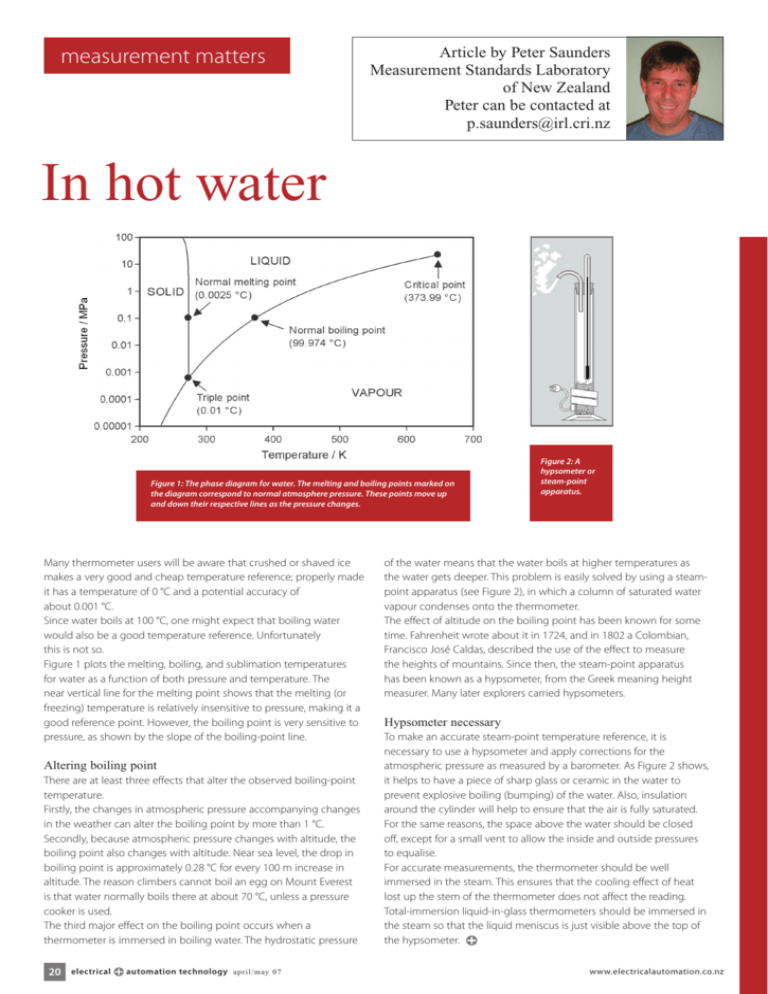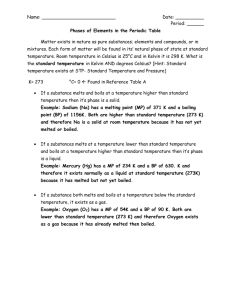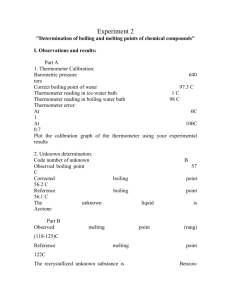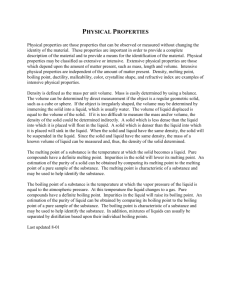In Hot Water
advertisement

measurement matters Article by Peter Saunders Measurement Standards Laboratory of New Zealand Peter can be contacted at p.saunders@irl.cri.nz In hot water Figure 1: The phase diagram for water. The melting and boiling points marked on the diagram correspond to normal atmosphere pressure. These points move up and down their respective lines as the pressure changes. Many thermometer users will be aware that crushed or shaved ice makes a very good and cheap temperature reference; properly made it has a temperature of 0 °C and a potential accuracy of about 0.001 °C. Since water boils at 100 °C, one might expect that boiling water would also be a good temperature reference. Unfortunately this is not so. Figure 1 plots the melting, boiling, and sublimation temperatures for water as a function of both pressure and temperature. The near vertical line for the melting point shows that the melting (or freezing) temperature is relatively insensitive to pressure, making it a good reference point. However, the boiling point is very sensitive to pressure, as shown by the slope of the boiling-point line. Altering boiling point There are at least three effects that alter the observed boiling-point temperature. Firstly, the changes in atmospheric pressure accompanying changes in the weather can alter the boiling point by more than 1 °C. Secondly, because atmospheric pressure changes with altitude, the boiling point also changes with altitude. Near sea level, the drop in boiling point is approximately 0.28 °C for every 100 m increase in altitude. The reason climbers cannot boil an egg on Mount Everest is that water normally boils there at about 70 °C, unless a pressure cooker is used. The third major effect on the boiling point occurs when a thermometer is immersed in boiling water. The hydrostatic pressure 20 electrical automation technology april/ m ay 07 Figure 2: A hypsometer or steam-point apparatus. of the water means that the water boils at higher temperatures as the water gets deeper. This problem is easily solved by using a steampoint apparatus (see Figure 2), in which a column of saturated water vapour condenses onto the thermometer. The effect of altitude on the boiling point has been known for some time. Fahrenheit wrote about it in 1724, and in 1802 a Colombian, Francisco José Caldas, described the use of the effect to measure the heights of mountains. Since then, the steam-point apparatus has been known as a hypsometer, from the Greek meaning height measurer. Many later explorers carried hypsometers. Hypsometer necessary To make an accurate steam-point temperature reference, it is necessary to use a hypsometer and apply corrections for the atmospheric pressure as measured by a barometer. As Figure 2 shows, it helps to have a piece of sharp glass or ceramic in the water to prevent explosive boiling (bumping) of the water. Also, insulation around the cylinder will help to ensure that the air is fully saturated. For the same reasons, the space above the water should be closed off, except for a small vent to allow the inside and outside pressures to equalise. For accurate measurements, the thermometer should be well immersed in the steam. This ensures that the cooling effect of heat lost up the stem of the thermometer does not affect the reading. Total-immersion liquid-in-glass thermometers should be immersed in the steam so that the liquid meniscus is just visible above the top of the hypsometer. www.electricalautomation.co.nz






